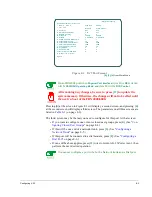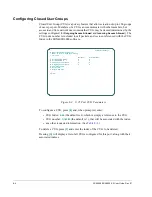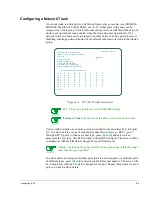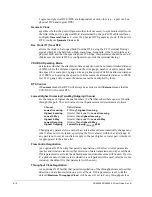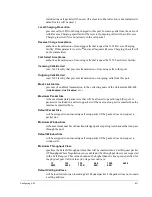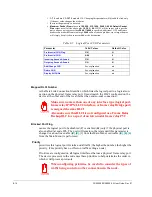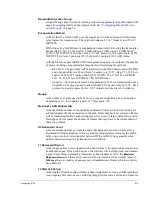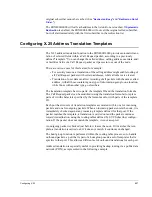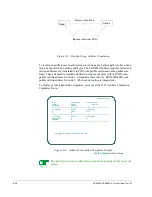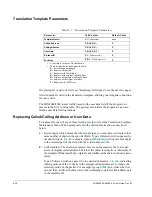
Configuring X.25
8-17
Bandwidth Allocation Group
assigns the logical port to one of sixteen groups whose parameters regulate bandwidth
usage by outgoing traffic on the physical link. See "
Configuring Bandwidth Allo-
cation Groups
" on page 7-6.
Encapsulation Method
is the method by which traffic over the logical port will be enveloped within frame
relay frames for transmission. The valid methods are T1.617 Annex G and T1.617
RFC1490.
With Annex G, a LAPB frame is encapsulated immediately following the frame relay
header (flag, 2-byte T1.618 header, LAPB address, LAPB control, LAPB I-field
[x.25/x.75]). With RFC1490, the order is: T1.618 header, Q.922 control byte, Q.933
NLPID, 2-byte level-2 protocol ID, 2-byte level-3 protocol ID, LAPB frame.
Although it may appear that RFC1490 encapsulation uses more overhead, the number
of protocols being encapsulated are important in determining the method:
●
RFC1490 – The protocols will be identified on the DLCI based on their NLPIDs
and (if applicable) level-2 and level-3 headers (e.g., X.25: flag, T1.618 2-byte
header, 0x03 Q.922 control, 0x08 Q.933 NLPID, T1.617 level-2 LAPB PID
0x51 81, T1.617 level-3 PID 0x67 80, LAPB frame).
●
Annex G – Each protocol must be encapsulated in X.25 for transmission over a
single DLCI, because Annex G allows the DLCI to be used only by X.25. Each
protocol in would require its own X.25 virtual circuit and level-3 windows.
Modulo
is the number of values used in X.25 level-2 sequenced packets. The actual packet
numbering is 0–7 for modulo 8 and 0–127 for modulo 128.
Maximum LAPB Window Size
is the maximum number of sequentially numbered I-frames that can be waiting for
acknowledgment by the next station in the path. If this number is exceeded, no frames
will be transmitted until an acknowledgment is received. A larger value allows faster
throughput, but increases the number of frames that may have to be retransmitted if
there is a problem.
N2 Retransmit Count
is the maximum number of times the node will attempt to send an I-frame after a
Retransmit Period expiration. A larger value for this parameter increases the proba-
bility of an eventual correct transfer between DTE and DCE, but a smaller value
permits faster detection of a permanent error condition.
T1 Retransmit Period
is the length of time before transmission of an I-frame if the previous transmission is
not acknowledged. If the period expires, the software will reset the timer and transmit
a supervisory frame demanding immediate acknowledgment. Also, the
Maximum
Retransmissions
(see that entry) counter will be incremented. The default value of
3000 ms
allows avoidance of unnecessary retransmission of frames that have merely
been delayed.
T2 Wait Ack Period
is the length of time the node will delay acknowledgment of a received I-frame if there
is no outgoing I-frame to be sent. If during this period the node receives an I-frame for
Содержание Netlink FRX4000
Страница 2: ......
Страница 16: ...xiv FRX4000 FRX6000 4 0 User Guide Rev 01 ...
Страница 17: ...Section I Getting Started ...
Страница 18: ......
Страница 24: ......
Страница 37: ...Section II Configuration ...
Страница 38: ......
Страница 52: ......
Страница 78: ......
Страница 106: ...7 24 FRX4000 FRX6000 4 0 User Guide Rev 01 ...
Страница 142: ...8 36 FRX4000 FRX6000 4 0 User Guide Rev 01 ...
Страница 186: ......
Страница 216: ......
Страница 266: ......
Страница 273: ...Section III Operation ...
Страница 274: ......
Страница 296: ......
Страница 324: ......
Страница 376: ......
Страница 377: ...Section IV Appendices ...
Страница 378: ......
Страница 384: ......
Страница 390: ......
Страница 396: ......
Страница 400: ......
Страница 405: ...Menu Structure E 5 ...
Страница 406: ...E 6 FRX4000 FRX6000 4 0 User Guide Rev 01 ...
Страница 425: ......
Страница 426: ......

